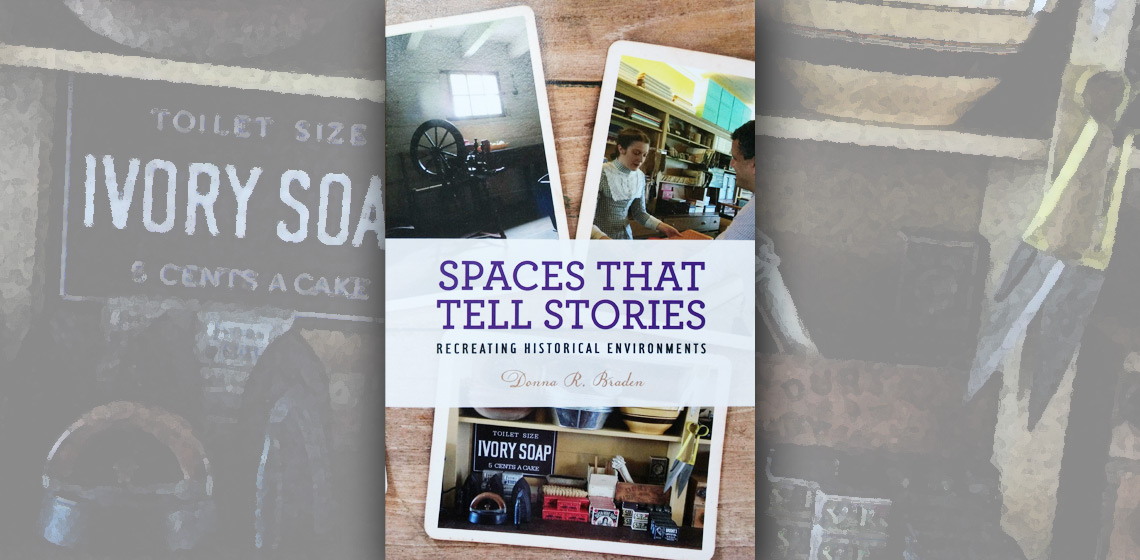
Spaces that tell stories: Recreating historical Environments is a textbook and a how-to manual for those setting up a new exhibition or living history site, or for those evaluating existing interpretation on a site. Everybody who works in museum education, exhibition and living history knows how fantastic it is when an historical environment engages a visitor in the topic. We also know how difficult it can be to achieve this. The road to a finished historical space is long and we often skip a step or two, because we “know” what works and how things would have looked.
What Donna R. Braden advocates is to be thorough, to be consistent, to do the research, to write the storyline, to think of all aspects and to skip no steps.
Spaces that tell stories is a handbook, a guidebook and a source of knowledge to a curator setting up a new historic environment in any location and exploring any time period. It shows the importance of setting up a narrative for an historic site. as is evident in many sections of the book.
The book is divided into two parts: the first two chapters give the historical background of historical environments (mostly in USA) and the importance of these spaces in education.
Braden does something that a lot of museum curators will frown upon – she involves and uses Disneyland and their ”imagineers” (the people who design all the exhibitions and rides) as an example of how an exhibition or a living history space should be thought through; that the smallest detail is of importance to create the perfect scene. This is something that Disney understood and that is still in use in the parks today.
I can remark that when we started our new big project at The Medieval Centre (Griffenholm, which opened in July 2019) we went on a study trip to Disneyland Paris to look at how they incorporated interpretation and experience in everything: even waiting in line was an experience and told part of the story leading up to the amusement. It is the idea of immersion and making the entire visit an experience that we as curators and employees of a living history site can take with us from Disneyland, not just the plastic and pastel colours.
The handbook part of the book is divided into chapters that describe each step from initial idea to fully finished exhibition. Braden takes you by the hand and carefully leads you through the steps: from chapter 3-6; ”Framing Your Project”, ”Your Research Methodology”, ”Bringing Your Environment to Life” and ”At Last! Creating Your Environment”.
Each chapter is a step-by-step guide on how to start each step and outlines what is needed for this step to be completed. Every chapter has a short summary and a thorough bibliography which can prove helpful in the line of work.
For a trained curator the creation of such a book can seem irrelevant, but it really is not. Even I got caught a couple of times thinking that the steps outlined in the book were merely common sense, and have often concluded that previous works we had undertaken could have benefited from having this material as reference. This is a gentle reminder to all of us to do our work properly the first time. This means that when new employees or interpreters are hired, they can easily refer to the document for important information about the exhibition.
There are some repetitions throughout the book, especially in the sum ups after each chapter, but also from one chapter to another. It can feel a bit irrelevant, but as the book can be used as a handbook, it can be used to look up questions or specific subjects so it makes sense that the reader might only read the chapter of interest.
There is a lot of text, but there are also good illustrations which prove the point of the text. The book is not easy to read but it can be seen as more of a tool that is useful when starting a new project.
I recommend it to anyone who needs a refresher as to why we do what we do and especially how to do it so that the visitor get the best possible experience. And so we don’t do more work than necessary by planning ahead and making sure we take notes and write documents with all the information.
A living history space is just as much a part of the museum collection as the reconstructions and historical objects, and therefore needs to be registered in a database and recorded for the future generations.
The book is part of a series published by the American Association for State and Local History.
Book information:
Braden, D.R. 2019. Spaces that Tell Stories. Recreating Historical Environments. London: Romand and Littlefield. 183 pages.
ISBN 978-1-5381-1102-4 (Hardback)